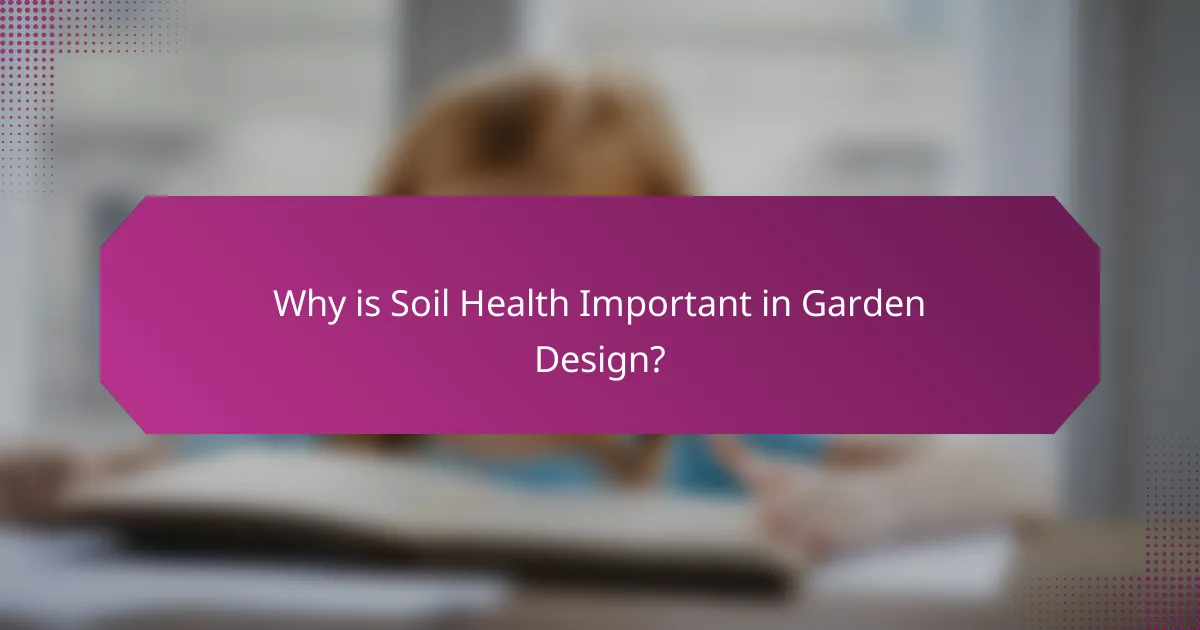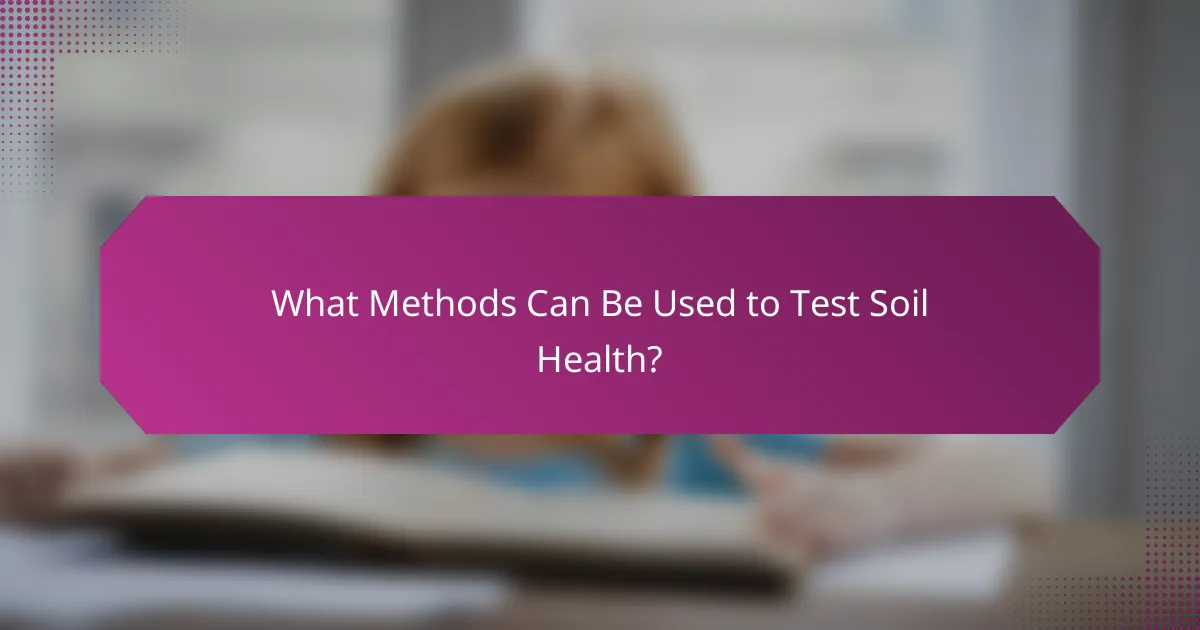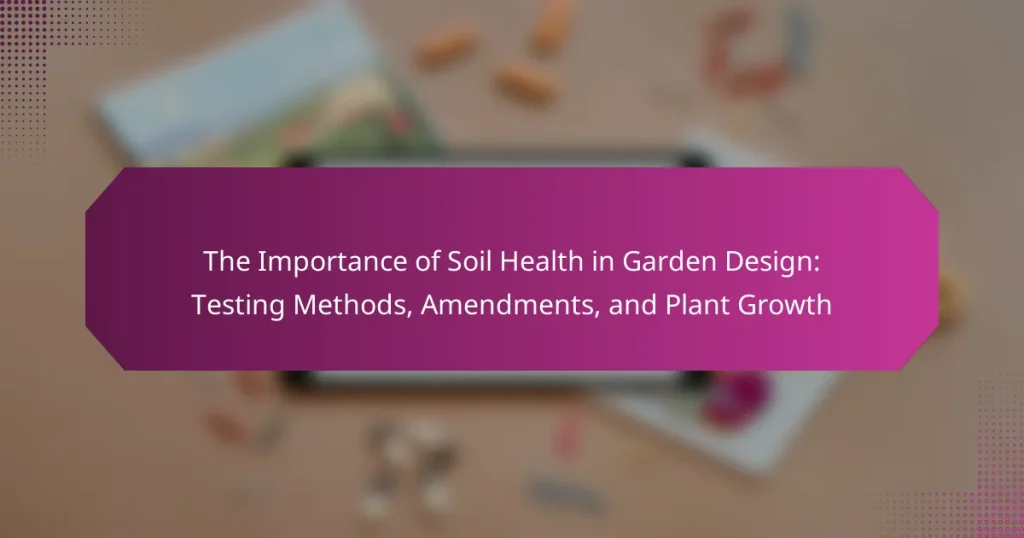
Why is Soil Health Important in Garden Design?
Soil health is crucial in garden design because it directly affects plant growth and ecosystem sustainability. Healthy soil provides essential nutrients, retains moisture, and supports beneficial microorganisms. These factors enhance root development and plant resilience. Research shows that well-structured soil can improve crop yields by up to 30%. Additionally, healthy soil reduces erosion and promotes biodiversity. This leads to a balanced ecosystem that supports various plant species. Therefore, prioritizing soil health is fundamental for successful and sustainable garden design.
What are the key components of soil health?
The key components of soil health include soil structure, organic matter, nutrient availability, and biological activity. Soil structure refers to the arrangement of soil particles, which affects water infiltration and root growth. Organic matter improves soil fertility and moisture retention. Nutrient availability is crucial for plant growth and is influenced by soil pH and microbial activity. Biological activity involves the presence of microorganisms and earthworms, which enhance nutrient cycling and soil aeration. Healthy soil supports diverse plant life and contributes to overall ecosystem resilience.
How do soil nutrients impact plant growth?
Soil nutrients are essential for plant growth. They provide the necessary elements for various physiological processes. Key nutrients include nitrogen, phosphorus, and potassium. Nitrogen promotes leaf and stem growth. Phosphorus aids in root development and flowering. Potassium improves overall plant health and disease resistance. A deficiency in any of these nutrients can lead to stunted growth or poor yields. For instance, studies show that nitrogen deficiency can reduce crop yields by up to 50%. Adequate soil nutrients ensure robust plant development and increased productivity.
What role does soil structure play in garden design?
Soil structure plays a critical role in garden design. It affects water retention, drainage, and root development. Well-structured soil promotes healthy plant growth. Soil with good structure enhances aeration and nutrient availability. Poor soil structure can lead to compacted layers that hinder root [censured]. Research indicates that soils with granular structure support diverse microbial activity. This microbial activity is essential for nutrient cycling. Therefore, understanding soil structure is vital for creating sustainable garden environments.
How does soil health influence garden sustainability?
Soil health directly influences garden sustainability by affecting plant growth and ecosystem balance. Healthy soil provides essential nutrients, supports microbial activity, and retains moisture. This leads to robust plant development and resilience against pests and diseases. Research shows that soil rich in organic matter can increase water retention by up to 30%. Sustainable gardens rely on this capacity to thrive with minimal external inputs. Additionally, healthy soil promotes biodiversity, which enhances pollination and pest control. Therefore, maintaining soil health is crucial for long-term garden sustainability.
Why is biodiversity in soil crucial for a healthy garden?
Biodiversity in soil is crucial for a healthy garden because it enhances soil fertility and resilience. Diverse soil organisms, including bacteria, fungi, and earthworms, contribute to nutrient cycling. They break down organic matter, releasing essential nutrients for plants. This process supports plant growth and increases yield. Biodiversity also improves soil structure, promoting better water retention and aeration. Healthy soil ecosystems can suppress pests and diseases, reducing the need for chemical interventions. Research shows that gardens with greater soil biodiversity yield healthier plants. Thus, maintaining soil biodiversity is essential for sustainable gardening practices.
What are the long-term benefits of maintaining soil health?
Maintaining soil health provides numerous long-term benefits. Healthy soil enhances plant growth and productivity. It improves nutrient retention, allowing plants to access essential minerals. Furthermore, healthy soil promotes biodiversity, supporting various microorganisms and insects. This biodiversity contributes to natural pest control and disease resistance. Additionally, maintaining soil health improves water retention. Well-structured soil reduces erosion and runoff, protecting water quality. Healthy soil also sequesters carbon, mitigating climate change effects. Studies show that healthy soils can increase crop yields by up to 20% over time. Overall, maintaining soil health is crucial for sustainable agriculture and environmental resilience.

What Methods Can Be Used to Test Soil Health?
Soil health can be tested using various methods. Common methods include soil pH testing, which measures acidity or alkalinity. Soil texture analysis determines the proportion of sand, silt, and clay. Nutrient testing identifies levels of essential elements like nitrogen, phosphorus, and potassium. Microbial activity tests assess the presence and health of soil microorganisms. Organic matter content analysis measures the amount of decomposed plant and animal material. Soil respiration tests evaluate the soil’s biological activity. Each method provides insights into the soil’s condition and fertility, supporting informed gardening decisions.
How can gardeners assess soil quality?
Gardeners can assess soil quality through various testing methods. They can conduct a soil test to analyze pH, nutrient levels, and organic matter. Soil tests provide quantitative data on essential nutrients like nitrogen, phosphorus, and potassium. A pH level between 6.0 and 7.0 is generally ideal for most plants. Gardeners can also perform a texture test by feeling the soil, which reveals its composition of sand, silt, and clay. Observing soil color can indicate organic content; darker soils often have higher organic matter. Additionally, examining soil structure helps assess drainage and aeration. Healthy soil should crumble easily and have a granular texture. These methods allow gardeners to make informed decisions about soil amendments and plant selection.
What are common soil testing methods?
Common soil testing methods include pH testing, nutrient analysis, and texture analysis. pH testing measures the acidity or alkalinity of soil. This is crucial for understanding nutrient availability. Nutrient analysis evaluates levels of essential elements like nitrogen, phosphorus, and potassium. It helps determine necessary amendments for optimal plant health. Texture analysis assesses soil composition, including sand, silt, and clay ratios. This influences water retention and drainage capabilities. These methods provide essential data for effective garden design and soil management. Accurate testing leads to informed decisions on soil amendments and plant selection.
How do laboratory tests differ from DIY soil tests?
Laboratory tests provide more accurate and comprehensive soil analysis compared to DIY soil tests. Professional laboratories use advanced equipment and standardized methods to assess soil properties. They can measure nutrient levels, pH, organic matter, and contaminants with precision. In contrast, DIY tests often rely on simple kits that may lack sensitivity and specificity. Laboratory tests can identify micronutrients and toxic elements that DIY kits might miss. Additionally, results from laboratories are typically validated and interpreted by experts. This ensures that recommendations for soil amendments are based on reliable data. Overall, laboratory tests offer a more thorough understanding of soil health essential for effective garden design.
What indicators should gardeners look for during soil testing?
Gardeners should look for pH level, nutrient content, organic matter, and soil texture during soil testing. The pH level indicates soil acidity or alkalinity, which affects nutrient availability. Nutrient content includes essential elements like nitrogen, phosphorus, and potassium. Organic matter improves soil structure and fertility. Soil texture, determined by the proportion of sand, silt, and clay, influences water retention and drainage. Testing these indicators helps gardeners optimize plant growth and health.
How do pH levels affect soil health?
Soil pH levels significantly affect soil health. pH influences nutrient availability to plants. Most nutrients are optimally available in a pH range of 6 to 7. When soil pH is too low, it can lead to nutrient deficiencies. For example, iron becomes more available in acidic soils. Conversely, high pH levels can cause nutrient lockout, particularly for phosphorus. Soil microorganisms also thrive within specific pH ranges, impacting organic matter decomposition. Research shows that pH levels directly correlate with plant growth and yield. Maintaining balanced pH is essential for healthy soil ecosystems.
What is the significance of organic matter in soil tests?
Organic matter is significant in soil tests as it influences soil fertility and structure. It enhances nutrient availability for plants. Organic matter improves water retention and aeration in the soil. It supports beneficial microbial activity, which is essential for soil health. Studies show that soils with higher organic matter content yield better crop production. For instance, a 2018 study by the USDA found that increasing organic matter by just 1% can improve soil moisture retention significantly. This leads to healthier plants and better garden design outcomes.

What Amendments Can Improve Soil Health?
Organic matter, such as compost, can significantly improve soil health. Compost enhances soil structure and increases nutrient availability. It also boosts microbial activity, which is essential for nutrient cycling. Gypsum is another amendment that can improve soil health. Gypsum helps to improve soil drainage and reduces compaction. Additionally, lime can be used to raise soil pH levels in acidic soils. This adjustment promotes nutrient availability for plants. Cover crops are also beneficial as they prevent erosion and improve soil fertility. Incorporating these amendments can lead to healthier, more productive soils.
What are the most effective soil amendments?
Organic matter is one of the most effective soil amendments. It improves soil structure, increases nutrient retention, and enhances microbial activity. Common sources of organic matter include compost, aged manure, and leaf mold. These materials enrich the soil with essential nutrients.
Another effective amendment is lime, which raises soil pH in acidic soils. This adjustment promotes nutrient availability for plants. Gypsum is also beneficial; it improves soil structure and drainage without altering pH.
Additionally, rock phosphate serves as a slow-release phosphorus source. It supports root development and flowering in plants.
Finally, biochar is gaining popularity for its ability to retain moisture and improve soil fertility. Studies show that these amendments significantly enhance soil health and plant growth.
How do organic amendments benefit the soil?
Organic amendments improve soil health by enhancing its structure, fertility, and biological activity. They increase soil organic matter, which helps retain moisture and nutrients. This retention supports plant growth and reduces erosion. Organic amendments also promote beneficial microbial activity, which aids in nutrient cycling. Research shows that soils amended with organic materials have higher levels of essential nutrients like nitrogen and phosphorus. Additionally, organic amendments can help suppress soil-borne diseases. Overall, these benefits contribute to more resilient and productive garden ecosystems.
What role do inorganic fertilizers play in soil health?
Inorganic fertilizers provide essential nutrients that enhance soil health. They supply macronutrients like nitrogen, phosphorus, and potassium, which are vital for plant growth. These fertilizers can improve soil fertility and increase crop yields. Regular application can help replenish nutrient-depleted soils. However, excessive use may lead to soil acidification and nutrient imbalances. Soil health can also be negatively impacted by runoff, which may cause water pollution. Therefore, careful management of inorganic fertilizers is crucial for sustainable soil health.
How should amendments be applied for best results?
Amendments should be applied based on soil test results. Conducting a soil test identifies nutrient deficiencies and pH levels. Based on these results, select appropriate amendments such as compost, lime, or fertilizers. Apply amendments evenly across the garden area. Incorporate them into the top 6 to 12 inches of soil. This ensures better nutrient availability for plants. Water the area after application to help amendments integrate into the soil. Regularly re-test soil every few years to adjust amendments as needed. Research indicates that proper amendment application can improve plant growth by up to 30%.
What are the best practices for incorporating amendments into the soil?
The best practices for incorporating amendments into the soil include proper timing, thorough mixing, and appropriate application rates. Timing is crucial; amendments should be added before planting or during the off-season. This allows the soil to benefit from the amendments without disrupting plant growth. Thorough mixing ensures even distribution of amendments throughout the soil. This can be achieved using a tiller or garden fork.
Application rates depend on the type of amendment and soil condition. For example, compost is typically added at a rate of 1 to 3 inches per year. Testing soil before amendment application is essential. Soil tests provide information on nutrient levels and pH, guiding the choice of amendments.
Incorporating organic matter, such as compost or well-rotted manure, improves soil structure and fertility. These materials enhance microbial activity, which is vital for nutrient availability. Additionally, applying amendments in layers rather than all at once can prevent nutrient leaching and promote gradual absorption.
Finally, monitoring soil moisture after amendment incorporation is important. Proper moisture levels help activate the amendments and support plant growth. Following these practices can lead to healthier soil and improved garden performance.
How often should soil amendments be reapplied?
Soil amendments should generally be reapplied every 1 to 3 years. The frequency depends on the type of amendment and the specific needs of the soil. Organic amendments, like compost, may need annual application to maintain soil structure and nutrient levels. In contrast, mineral amendments, such as lime or gypsum, may require less frequent application based on soil tests. Regular soil testing can provide guidance on nutrient levels and pH balance. This ensures that amendments are applied when necessary, optimizing soil health and plant growth.
What are the best practices for maintaining soil health in garden design?
Best practices for maintaining soil health in garden design include regular soil testing, organic matter addition, and crop rotation. Soil testing identifies nutrient deficiencies and pH levels. Adding organic matter, such as compost, improves soil structure and fertility. Crop rotation prevents nutrient depletion and reduces pest buildup. Cover crops protect soil from erosion and enhance nutrient cycling. Mulching conserves moisture and suppresses weeds. Minimizing soil disturbance preserves soil organisms and structure. Implementing these practices supports healthy plant growth and sustainable gardening.
How can gardeners troubleshoot common soil health issues?
Gardeners can troubleshoot common soil health issues by conducting soil tests. Soil tests reveal pH levels, nutrient deficiencies, and organic matter content. A pH level between 6.0 and 7.5 is ideal for most plants. If the pH is too low, adding lime can help raise it. If the pH is too high, sulfur can lower it. Nutrient deficiencies can be addressed by applying appropriate fertilizers. Organic matter can be improved by adding compost or well-rotted manure. Regular monitoring and adjusting practices based on test results ensure optimal soil health. Studies show that healthy soil promotes better plant growth and resilience.
The main entity of this article is soil health in garden design. The article highlights the significance of soil health for plant growth, ecosystem sustainability, and garden productivity. Key components of soil health, such as soil structure, organic matter, nutrient availability, and biological activity, are examined. It discusses the impact of soil nutrients on plant growth and the role of soil structure in creating sustainable gardens. Additionally, the article outlines methods for testing soil health, effective amendments to improve soil quality, and best practices for maintaining soil health in garden design.


